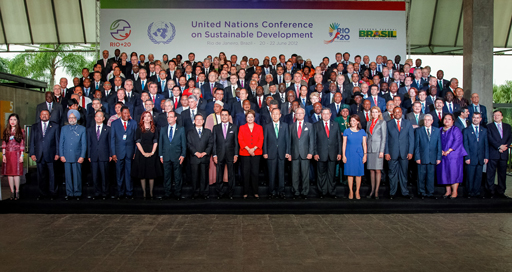14.2 Types of international agreement
International agreements take various forms depending on their stage of negotiation and implementation and whether they are intended to detail aims and aspirations or legal rights and duties. In this section we will consider some international agreements developed by the United Nations that have formed global environmental policies.
The United Nations (UN) is an intergovernmental global organisation with 193 member states (including Ethiopia) that promotes and facilitates international cooperation in order to address global concerns such as maintaining international peace and security, solving international problems and encouraging respect for human rights (United Nations, 1945). UN summits and conferences bring together representatives of the member states to discuss transboundary issues (Figure 14.3).

Every member nation has the right to raise its concerns with the UN and can propose items for the agenda of the General Assembly, the UN’s main deliberative body. The self-interest of individual countries and the common interests of the international community can be in conflict. This means international agreement can be difficult to obtain and the process of developing agreements through the UN is highly political, involving many negotiations. Following drafting, discussion and negotiation on their details, many multilateral treaties are adopted by the UN General Assembly and subsequently implemented by the member states.
The terminology for international agreements is complicated. Several words have meanings that overlap and they are not always used consistently. Table 14.1 explains the most usual meanings of various terms used to describe the different types of agreement. Beyerlin and Marauhn (2011) listed 194 of these various agreements that apply internationally.
| Type of initiative | Characteristics |
| Agreement | Can be used generically to mean international agreement in its broadest sense including the widest range of international collaborations. It can also be used more specifically to describe initiatives that are less formal than conventions or treaties and often deal with a narrower range of subject matter. |
| Convention | Generally used for formal multilateral treaties with many parties; normally open for participation by the international community as a whole, or by a large number of states. A convention becomes legally binding on the states that sign up and ratify it. |
| Treaty | Embraces all agreements that are binding in international law; treaties are intended to create legal rights and duties. |
| Declaration | Usually used to declare aspirations rather than to create binding obligations. |
| Protocol | A supplementary document used to add detail or additional rights and obligations to a convention or treaty. |
In order to come into force, an international convention or treaty needs to be ratified, which means individual states agree to be legally bound by it. Once an international agreement is ratified, then that agreement is enforced and monitored internationally. However, this applies only to the states that have ratified the convention and agreed to be bound by its conditions. For example, Ethiopia has ratified two conventions on the control of hazardous wastes, the Basel Convention and the Bamako Convention (described in Section 14.5).
A protocol, containing details of technical and administrative provisions, can be used to create legally binding obligations in international, and subsequently national, law. An example of such a protocol is the Kyoto Protocol on climate change, which was created under the United Nations Framework Convention on Climate Change (see Section 14.4).
Examples of declarations include the Declaration of Human Rights of 1948, the 1992 Rio Declaration on Environment and Development, the 2000 United Nations Millennium Declaration and the 2002 Johannesburg Declaration on Sustainable Development.
Note that UN initiatives are often referred to by the name of the place where they were created: for example, the Bamako Convention was agreed at a meeting in Bamako, Mali; the Kyoto Protocol from Kyoto, Japan, etc.
In the following sections, we will look at some of the main international agreements relevant to environment and WASH, organised by the topics they cover.
14.1 Why are global environmental policies needed?
